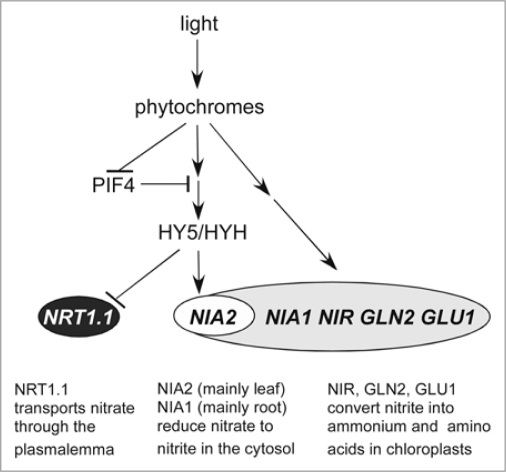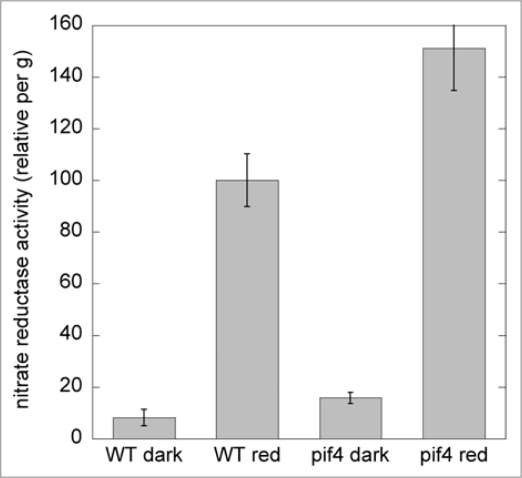Abstract
Light perceived by phytochromes will induce genes of nitrogen assimilation, however, transducing components in the signaling cascades to these genes are hardly known. Recently the bZIP transcription factors HY5 (LONG HYPOCOTYL5) and HYH (HOMOLOG OF HY5) were identified as positive regulators in light activation of NIA2 (nitrate reductase 2). The bHLH transcription factor PIF4 (PHYTOCHROME INTERACTING FACTOR 4) was revealed as an inhibitor of NIA2 expression. In contrast to NIA2, expression of other genes of nitrogen assimilation, NRT1.1 (dual-affinity nitrate transporter 1.1), NIA1 (nitrate reductase 1), NIR (nitrite reductase), GLN2 (glutamine synthetase 2) and GLU1 (glutamate synthase 1) were not promoted by HY5/HYH or inhibited by PIF4. NIA2 as the outstanding gene of nitrate assimilation regarding HY5/HYH and PIFs may have evolved in connection with the cytosolic leaf localization of nitrate reductase, and adverse effects of the products, nitrite, nitric oxide and active oxygen species formed by the enzyme.
Key words: bHLH, bZIP, HY5, nitrogen assimilation, nitrate reductase, phytochrome, PIF4
In seedlings, light perceived by phytochromes induces activation of genes promoting photomorphogenesis as strikingly characterized by short hypocotyls, cotyledon expansion and greening. Various downstream components of phytochromes are involved, and the bZIP transcription factor HY5 (LONG HYPOCOTYL5) is crucial in many of the signaling cascades promoting photomorphogenesis.1,2 A group of bHLH transcription factors called PIFs (phytchrome interacting factors) are also downstream factors of phytochromes, and may promote or counteract responses to light.3–5 Some genes forming a functional cluster are regulated by a common downstream factor as found for example in a subset of the flavonoid pathway genes activated by HY5 binding to their promoters. Furthermore, these flavonoid pathway genes are also activated by binding of a PIF (PIF3) to their promoters.6 Light perceived by phytochromes will lead to rapid degradation of PIFs1 thereby influencing PIF-dependent processes. Effects of different PIFs can be additive;7,8 single pif mutations had only small effects, whereas a constitutive photomorphogenetic phenotype (even in darkness) was found for seedlings of the quadruple pif1pif3pif4pif5 mutant.8 The full picture of phytochrome signaling is far from clear, and indeed very complex since components can act both as inhibitors and enhancers, depending on environment, tissue and process in question. Also a range of different phytochromes are present (five in Arabidopsis) which add complexity by homodimerizing and heterodimerizing.9 Although phytochrome signaling to genes of photosynthesis and flavonoid metabolism has been more intensively studied, light absorbed by phytochromes has also long been known to induce activation of genes in the nitrogen assimilation pathway in various plant species.10–12 However, downstream components of phytochromes in the signaling pathways to nitrogen metabolism have hardly been investigated.1,13
We examined the involvement of phytochromes and putative downstream factors in nitrogen assimilation by comparing various loss-off-function mutants.14,15 HY5 and HYH (HOMOLOG OF HY5) were shown to be positive modulators of far-red and red-light-signaling to NIA2. NIA2 is one of the two nitrate reductase genes in Arabidopsis, and is the gene dominantly expressed in green leaves. Impairment of NIA2 expression in the hy5 hyh double mutant15 underpinned our previously findings that presence of HY5/HYH was a prerequisite for high nitrate reductase (NR) activity in seedlings grown in continuous red or far-red light.14 HY5/HYH as possible enhancers also of other genes in the nitrate assimilation pathway were tested.15 The genes examined were NRT1.1, which is established as a gene important for nitrate uptake in Arabidopsis,16 NIA1 (root-important NIA), and genes encoding enzymes for the subsequent steps in nitrate assimilation, i.e., NIR (nitrite reductase), GLN2 (glutamine synthetase 2), and GLU1 (glutamate synthase 1) (Fig. 1). In contrast to NIA2, the gene for nitrate uptake was negatively affected, and expression levels of the other genes of the nitrogen assimilation pathway were not influenced by presence of HY5/HYH.15 This is consistent with the genome wide analysis of HY5 binding by Lee et al.2 using a chromatin immunoprecipitation procedure, which revealed putative binding sites for HY5 in the NIA2 and NRT1.1 promoters, but not other genes depicted in Figure 1 (Suppl. material in Lee et al.). We also tested NR activity in single pif mutants (pif1, pif3 and pif4),5,7 which showed that NR activity was increased by 50% in the pif4 mutant in comparison with wild type in red-light-grown seedlings (Fig. 2). The positive effect on NR activity by the pif4 mutation was confirmed also in rosette leaves exposed to 72 h of darkness followed by 4 h red light. Interestingly, only NIA2 transcript level was clearly increased in pif4; expression of NRT1.1 was decreased, and other genes of nitrate assimilation were not consistently influenced (Sandsmark, unpublished). Recently, microarrays were used to investigate gene expression in a pif1pif3pif4pif5 quadruple mutant by Shin and coworkers.8 NIA2 was the only gene of nitrogen assimilation revealing enhanced expression in the quadruple mutant (Suppl. material in Shin et al.),8 which confirms the exceptional regulation of the NIA2 gene as opposed to other genes of nitrate assimilation regarding PIFs. This places PIF4 as an inhibitor of light-induced NIA2 expression in the signaling pathway (Fig. 1). It is intriguing that NIA2 expression, but not other genes of nitrate assimilation is activated by HY5/HYH and inhibited by PIF4. The reason for this is not known, but possibly the special localization of NR to the cytosol as opposed to further steps taking place in the chloroplasts, and the fact that NR produces products that can be toxic (nitrite, nitric oxide, reactive oxygen species)17 may have promoted evolution of the complex fine-tuning of NIA2 expression different from the other genes of nitrate assimilation.
Figure 1.
Schematic diagram summarizing positive and negative light effects on genes in the nitrate assimilation pathway of Arabidopsis seedlings. Continuous light (red, far-red, white) induced NIA2 and other genes involved in nitrate assimilation, whereas NRT1.1 was weakly inhibited by light. Light effects on NIA2 and NRT1.1 were enhanced by the presence of HY5/HYH. PIF4 was identified as an inhibitor of NIA2 expression. Our data are compatible with PIF4 acting through the HY5/HYH pathway because NIA2 and NRT1.1 were oppositely influenced in the pif4 mutant, and other genes of nitrate assimilation were not influenced. However, the available data do not determine if PIF4 rather act through a separate signaling cascade (not including HY5/HYH) to inhibit NIA2.
Figure 2.
Nitrate reductase activity is enhanced in pif4 seedlings grown in continuous red light (4 µmol m−2s−1) for six days compared with wild type (WT). Experimental conditions were as previously described.14,15 Data presented are means from four independent experiments. SE is given. NR activity was significantly higher in the pif4 mutant compared with wild type in red light (p < 0.05).
Acknowledgements
The pif1-2, pf3-3 and pif4-2 mutants were kindly provided by Prof Quail at the University of California, Berkeley, CA.
Footnotes
Previously published online: www.landesbioscience.com/journals/psb/article/9795
References
- 1.Bae G, Choi G. Decoding of light signals by plant phytochromes and their interacting proteins. Annu Rev Plant Biol. 2008;59:281–311. doi: 10.1146/annurev.arplant.59.032607.092859. [DOI] [PubMed] [Google Scholar]
- 2.Lee J, He K, Stolc V, Lee H, Figueroa P, Gao Y, et al. Analysis of transcription factor HY5 genomic binding sites revealed its hierarchical role in light regulation of development. Plant Cell. 2007;19:731–749. doi: 10.1105/tpc.106.047688. [DOI] [PMC free article] [PubMed] [Google Scholar]
- 3.Huq E, Quail PH. PIF4, a phytochrome-interacting bHLH factor, functions as a negative regulator of phytochrome B signaling in Arabidopsis. EMBO J. 2002;21:2441–2450. doi: 10.1093/emboj/21.10.2441. [DOI] [PMC free article] [PubMed] [Google Scholar]
- 4.Duek PD, Fankhauser C. bHLH class transcription factors take centre stage in phytochrome signalling. Trends Plant Sci. 2005;10:51–54. doi: 10.1016/j.tplants.2004.12.005. [DOI] [PubMed] [Google Scholar]
- 5.Monte E, Tepperman JM, Al-Sady B, Kaczorowski KA, Alonso JM, Ecker JR, et al. The phytochrome-interacting transcription factor, PIF3, acts early, selectively, and positively in light-induced chloroplast development. Proc Natl Acad Sci USA. 2004;101:16091–16098. doi: 10.1073/pnas.0407107101. [DOI] [PMC free article] [PubMed] [Google Scholar]
- 6.Shin J, Park E, Choi G. PIF3 regulates anthocyanin biosynthesis in an HY5-dependent manner with both factors directly binding anthocyanin biosynthetic gene promoters in Arabidopsis. Plant J. 2007;49:981–994. doi: 10.1111/j.1365-313X.2006.03021.x. [DOI] [PubMed] [Google Scholar]
- 7.Leivar P, Monte E, Al-Sady B, Carle C, Storer A, Alonso JM, et al. The Arabidopsis phytochromeinteracting factor PIF7, together with PIF3 and PIF4, regulates responses to prolonged red light by modulating phyB levels. Plant Cell. 2008;20:337–352. doi: 10.1105/tpc.107.052142. [DOI] [PMC free article] [PubMed] [Google Scholar]
- 8.Shin J, Kim K, Kang H, Zulfugarov IS, Bae G, Lee CH, et al. Phytochromes promote seedling light responses by inhibiting four negatively-acting phytochrome-interacting factors. Proc Natl Acad Sci USA. 2009;106:7660–7665. doi: 10.1073/pnas.0812219106. [DOI] [PMC free article] [PubMed] [Google Scholar]
- 9.Clack T, Shokry A, Moffet M, Liu P, Faul M, Sharrock RA. Obligate heterodimerization of Arabidopsis phytochromes C and E and interaction with the PIF3 basic helix-loop-helix transcription factor. Plant Cell. 2009;21:786–799. doi: 10.1105/tpc.108.065227. [DOI] [PMC free article] [PubMed] [Google Scholar]
- 10.Jones RW, Sheard RW. Nitrate reductase activity: phytochrome mediation of induction in etiolated peas. Nat New Biol. 1972;238:221–222. doi: 10.1038/newbio238221a0. [DOI] [PubMed] [Google Scholar]
- 11.Mohr HNA, Seith B. Control of nitrate reductase and nitrite reductase gene exorpession by light, nitrate and a plastidic factor. Bot Acta. 1992;105:81–89. [Google Scholar]
- 12.Tepperman JM, Hudson ME, Khanna R, Zhu T, Chang SH, Wang X, et al. Expression profiling of phyB mutant demonstrates substantial contribution of other phytochromes to red-light-regulated gene expression during seedling de-etiolation. Plant J. 2004;38:725–739. doi: 10.1111/j.1365-313X.2004.02084.x. [DOI] [PubMed] [Google Scholar]
- 13.Lillo C. Signalling cascades integrating light-enhanced nitrate metabolism. Biochem J. 2008;415:11–19. doi: 10.1042/BJ20081115. [DOI] [PubMed] [Google Scholar]
- 14.Jonassen EM, Lea US, Lillo C. HY5 and HYH are positive regulators of nitrate reductase in seedlings and rosette stage plants. Planta. 2008;227:559–564. doi: 10.1007/s00425-007-0638-4. [DOI] [PubMed] [Google Scholar]
- 15.Jonassen EM, Sevin DC, Lillo C. The bZIP transcription factors HY5 and HYH are positive regulators of the main nitrate reductase gene in Arabidopsis leaves, NIA2, but negative regulators of the nitrate uptake gene NRT1.1. J Plant Physiol. 2009;166:2071–2076. doi: 10.1016/j.jplph.2009.05.010. [DOI] [PubMed] [Google Scholar]
- 16.Tsay YF, Chiu CC, Tsai CB, Ho CH, Hsu PK. Nitrate transporters and peptide-transporters. FEBS Lett. 2007;581:2290–2300. doi: 10.1016/j.febslet.2007.04.047. [DOI] [PubMed] [Google Scholar]
- 17.Meyer C, Lea US, Provan F, Kaiser WM, Lillo C. Is nitrate reductase a major player in the plant NO (nitric oxide) game? Photosynth Res. 2005;83:181–189. doi: 10.1007/s11120-004-3548-3. [DOI] [PubMed] [Google Scholar]




